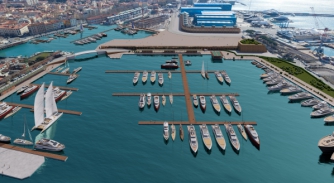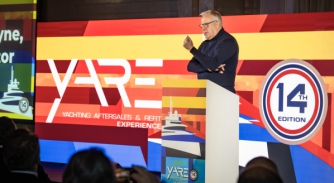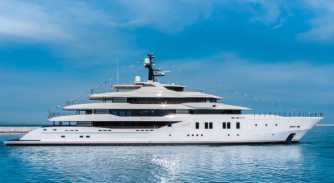Creating a new nautical code
Pietro Angelini, General Director of Navigo, on his proposal to introduce a new nautical code in Italy…
What’s the exact size of the market for yachts over 30 metres in Italy – and specifically for the Tuscan district stretching from Livorno to La Spezia? It may sound a strange question, but even in 2024, it is still difficult, if not impossible, to quantify.
Addressing this issue is Pietro Angelini, general director of Navigo, who recently presented the data for 2023 and the prospects for 2024 collected by the “Osservatorio Regionale della Nautica”. This data underline Italy’s position as the world’s largest player in the nautical industry, highlighting that 80 per cent of the national product and 35 per cent of the world’s yacht production is concentrated in the area stretching from Livorno to La Spezia.
According to Angelini, the data would be far more abundant if Italy had a code aimed exclusively at the nautical sector. Currently, there is only a generic code called Ateco, the classification of economic activities in Italy. Angelini is calling for a Nace code (Statistical Classification of Economic Activities in the European Community) along with the introduction of a new second-level code to prioritise operations in the nautical sector.
“When companies that work for the yachting industry deliver their balance sheets to their respective chambers of commerce, they should have the option of entering a code dedicated to boating. Otherwise, many companies that work for and with the boating industry are not correctly identified,” says Angelini. “Someone needs to start changing this by creating a nautical code that identifies all the companies that work for the nautical sector, even if they are active in other sectors. I am referring to carpenters, plumbers, electricians and all the different suppliers that contribute to the construction of a yacht but also work for the civil sector. How can you ascertain that they are also involved in the yachting industry? It is currently impossible.”
Angelini further explains that “in attempting to quantify the market scope of the Tuscan district, and more broadly that of Italy, they discovered a significant misconception: only 10 out of 70 codes are typically considered in national-level data.” He points out a case like Mobilart, a company with a turnover of around 50 million euros and 300 employees, which does not appear in lists of national nautical suppliers but is categorised solely under carpentry.

Pietro Angelini, general director, Navigo
Navigo is prepared to furnish a comprehensive list of shipyard suppliers “essential for accurately identifying those operating in the boating industry and thereby assessing the true scale of the Italian boating market,” Angelini explains. “This will enable a clearer understanding of the framework for making informed decisions and taking necessary actions, whether during sectoral crises or periods of robust performance.”
As for the state of health of the industry for yachts over 30 metres, the data presented by Navigo still indicates growth in the market, albeit more modestly compared to 2021/2022 when there was a peak in orders and production. “For the next few years, we expect limited growth, also because it’s challenging to gauge the dynamics of speculative builds without confirmed customer orders,” says Angelini. “This reflects shipyards’ cautious approach towards risk, which appears to be restrained at present. The speculative nature, a longstanding issue in interpreting sector data over the past 20 years, complicates determining whether there is an actual downturn or if speculation merely extends the positive cycle of the market. During this favourable period, finding clients doesn’t seem to be problematic, as emphasised by reports from brokers and major yachting groups.”
The analysis presented by Navigo focuses on the sector’s numerical data and its scale, rather than on turnover or the market itself. The macro-data of the sector are based on orders and contracts recorded by yacht manufacturers spanning the region from La Spezia to Livorno.
“In our three-year project, our aim is to implement geolocation of orders to track where yachts over 30 metres are being constructed, enabling precise mapping of production,” explains Angelini. “Our focus is on assessing the number of companies operating in the Tuscan area to determine the market scope and its associated economic impact in our region. This reinforces the understanding that these companies not only serve the local district but also contribute to foreign shipyards. For instance, Yachtline of Pisa, a global leader in producing fittings for mega and gigayachts, supplies not only local shipyards but also major international players like Lürssen. Similarly, Gianneschi Pumps and Blowers, a key market player in the global marine industry, provides pumps and blowers for luxury yachts, workboats and small military vessels ranging from 12 to 120 metres.”
“The data we analyse encompasses signed orders, vessels under construction in Tuscan shipyards and supplier interviews to ascertain their current projects,” continues Angelini. “This involves cross-referencing data from shipyards, industry surveys and our independent supplier research. From our first year's analysis, it’s evident that suppliers are operating on a scale exceeding local builder demands in the Tuscan district. This underscores their substantial export levels, with German and Dutch yacht builders notably sourcing from the Tuscan district.”
Angelini’s quest to develop a new nautical code is an example of how innovation can manifest itself through a simplification of bureaucracy. With the provision of more reliable data, the economic contribution of the yachting industry can be presented more accurately and illustrates how action can be taken promote its optimal development.
NEW: Sign up for SuperyachtNewsweek!
Get the latest weekly news, in-depth reports, intelligence, and strategic insights, delivered directly from The Superyacht Group's editors and market analysts.
Stay at the forefront of the superyacht industry with SuperyachtNewsweek
Click here to become part of The Superyacht Group community, and join us in our mission to make this industry accessible to all, and prosperous for the long-term. We are offering access to the superyacht industry’s most comprehensive and longstanding archive of business-critical information, as well as a comprehensive, real-time superyacht fleet database, for just £10 per month, because we are One Industry with One Mission. Sign up here.
Related news

RINA reports double-digit growth
The Italian classification society made around 800 million euros in revenue during 2023 and now plans to reach €2 billion by the end of the decade
Business

Piero Formenti to head Confindustria Nautica
The former senior vice president of Confindustria Nautica will lead the association as president following Saverio Cecchi's self-suspension
Business

Benetti and D-Marin to build new Italian marina
The Italian shipyard and international marina operator have partnered on a multi-million-euro project in Livorno to bolster regional superyacht traffic
Business

Review: YARE 2024
Dario Schiavo, Italy Editor, reflects on the 2024 edition of the Yachting Aftersales and Refit Experience in Viareggio
Business

CRN delivers 139
The fully custom 72 metre vessel from the Italian shipyard was designed, engineered and built in collaboration with Vallicelli Design and Nuvolari Lenard
Fleet
Related news
RINA reports double-digit growth
11 months ago
Piero Formenti to head Confindustria Nautica
11 months ago
Review: YARE 2024
1 year ago
CRN delivers 139
1 year ago
NEW: Sign up for
SuperyachtNewsweek!
Get the latest weekly news, in-depth reports, intelligence, and strategic insights, delivered directly from The Superyacht Group's editors and market analysts.
Stay at the forefront of the superyacht industry with SuperyachtNewsweek



